What type of cooking fuel to use in your camper van: Pros and Cons
What’s better than exploring the slot canyons of Zion? Settling down at the end of the day to a plate of crispy, mouthwatering, tacos. The truth is, you don’t need a spacious kitchen setup to create delectable food. It can all be made in the confines of a van.
The type of fuel you choose to cook with alters which type of stove you can buy; and how much money will be spent keeping the heat going. Take it from me. It’s not a pleasant lesson to learn on a frigid morning that you can’t cook potatoes because your butane stove won’t function below freezing.
If you play your cards right, some fuels can be used to power more than just cooking equipment. You can heat water, showers or even mini ovens in your van!
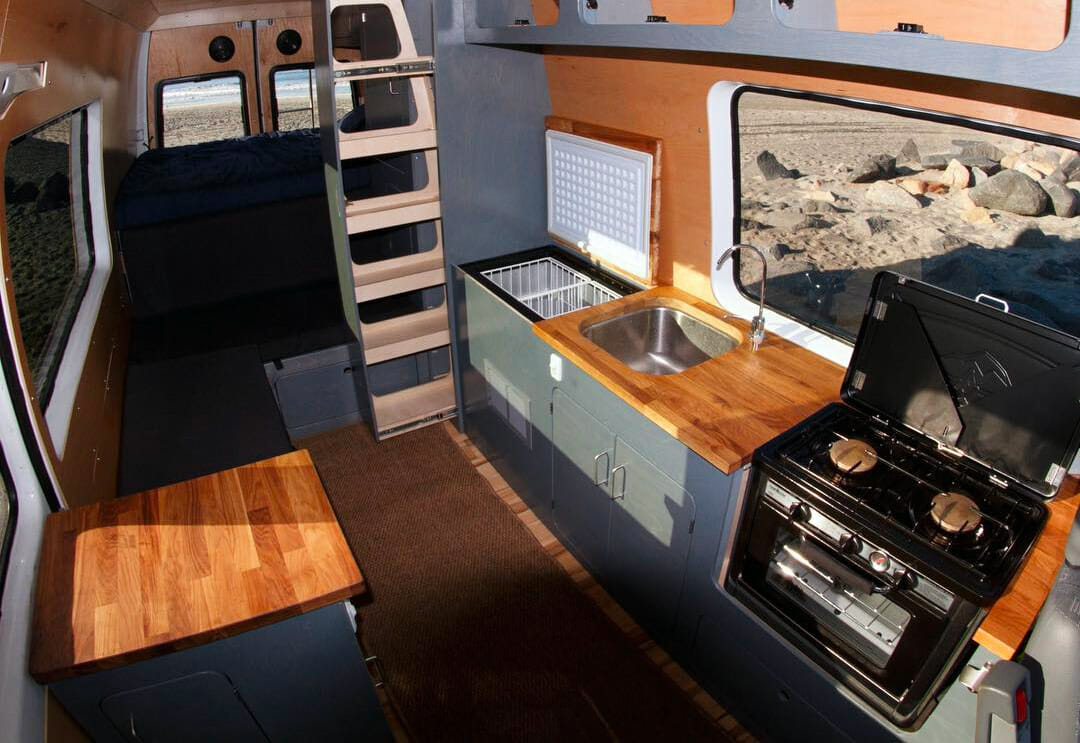
| Fuel Type | Standard Unit Size | Total BTUs Per Unit | Approx. Refill Cost (US $) | BTU Per $1 |
|---|---|---|---|---|
| Propane (tank) | 1 Gallon | 91,500 | $4.25 | 21,529 |
| Propane (canister) | 16oz. | 21,600 | $3.50 | 6,197 |
| Butane | 8oz. | 10,800 | $3.00 | 3,600 |
| Isobutane | 7.75oz. | 10,463 | $3.90 | 2,683 |
| Diesel | 1 Gallon | 129,500 | $3.25 | 39,846 |
| Gasoline | 1 Gallon | 114,000 | $3.00 | 38,000 |
| Kerosene | 1 Gallon | 135,000 | $8.50 | 15,882 |
| Sterno | 7oz. | 5,531 | $2.50 | 2,212 |
| Wood | 10lb. cord | 50,000 | - | - |
| Electricity | 1000Wh | 3,414 | - | - |
How Are Fuels Measured?
To compare fuel heat capacity, we use the British Thermal Unit (BTU). A BTU is the amount of heat required to take 1 pound of water up by 1 degree Fahrenheit.
The more BTUs a fuel has, the more heat it can generate.
But BTUs are only part of the story. A blacktop parking lot on a simmering summer day is putting out a lot of BTUs, yet this would only slightly warm up a cup of coffee. In this case, most of the heat is escaping into the air. A stove or oven is necessary to direct heat so it can be used for cooking.
Different Fuels Have Different Burning Points
Liquid fuels like butane and propane must turn to gas before burning. Butane fuel boils at 31ºF, while propane boils at -43ºF.
This means butane fuel will not light in weather below 31ºF. If you do a lot of winter camping and are cooking with butane, it will be necessary to warm the canister before it can be used.
Safety First!
When cooking using any kind of fuel, keep in mind that there are byproducts. Combustion produces water as well as CO2. Always use a carbon monoxide detector and proper ventilation when cooking indoors.
Cooking with Propane
Propane is the workhorse of fuel. It has the advantage of being inexpensive, readily available and can power a multitude of appliances. Although propane burns relatively clean, like all fuels it requires ventilation. Propane also works seamlessly in sub-freezing temperatures.
There are two types of propane to consider when designing your kitchen:
- Propane cylinders
- Refillable propane tanks
1lb. Propane Cylinders
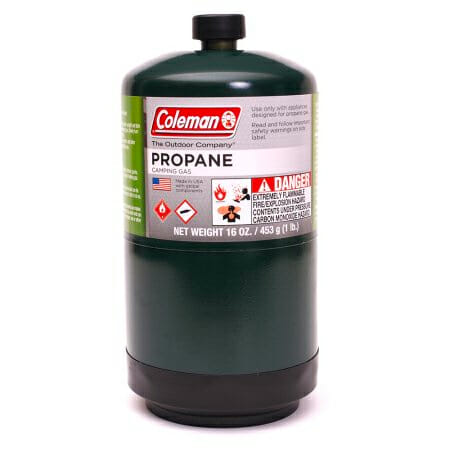
Propane cylinders can be bought for just a few dollars at camping and supermarket stores. While these cylinders are refillable, most people treat them as disposable cans. Small canisters of propane are popular and can be used to heat camping stoves like the Coleman Classic or the Camp Chef Everest.
Often camping stoves have the ability to use either the 1lb. propane cans or larger refillable tanks. The smaller propane cylinders are easier to store and allow for a more portable stove setup.
As a disadvantage, small propane canisters don’t last very long. They are also significantly more expensive than refilling large propane tanks unless you have access to a refilling device and spare propane take, which would not be found in a van setup.
Refillable Propane Tanks
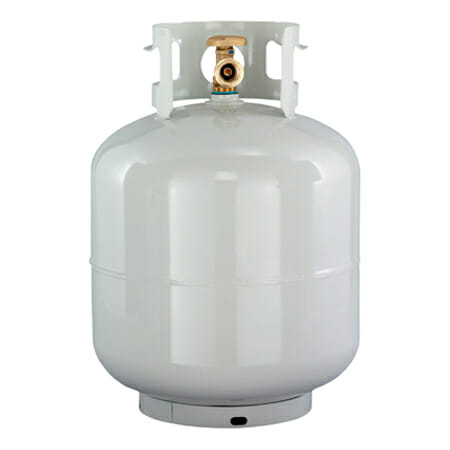
Larger, refillable propane tanks can be purchased at gas stations, grocery stores and any camping outlets.
In addition to using propane for stoves, the fuel tanks can be used to heat mini ovens, water for sinks or showers and even run a heater in frigid weather.
Standard portable propane tanks stand at about 18” tall and a foot and a half in diameter. Tanks weigh roughly 20 pounds empty and 37 pounds full. They hold 4.5 gallons of propane.
Propane tanks can take up valuable space and some planning to install. Fuel lines should be regularly checked to make sure there are no leaks.
Because propane tanks are so large, they make more sense for a dedicated adventure build. Many people install propane tanks on the outside of their vehicle for ventilation and refilling ease. Others install it inside in a sealed compartment with external ventilation.
The price and availability of fuel does makes these tanks economical. That said, it is a little bit of a giveaway on a stealth vehicle for the city because of the ventilation required for a large tank.
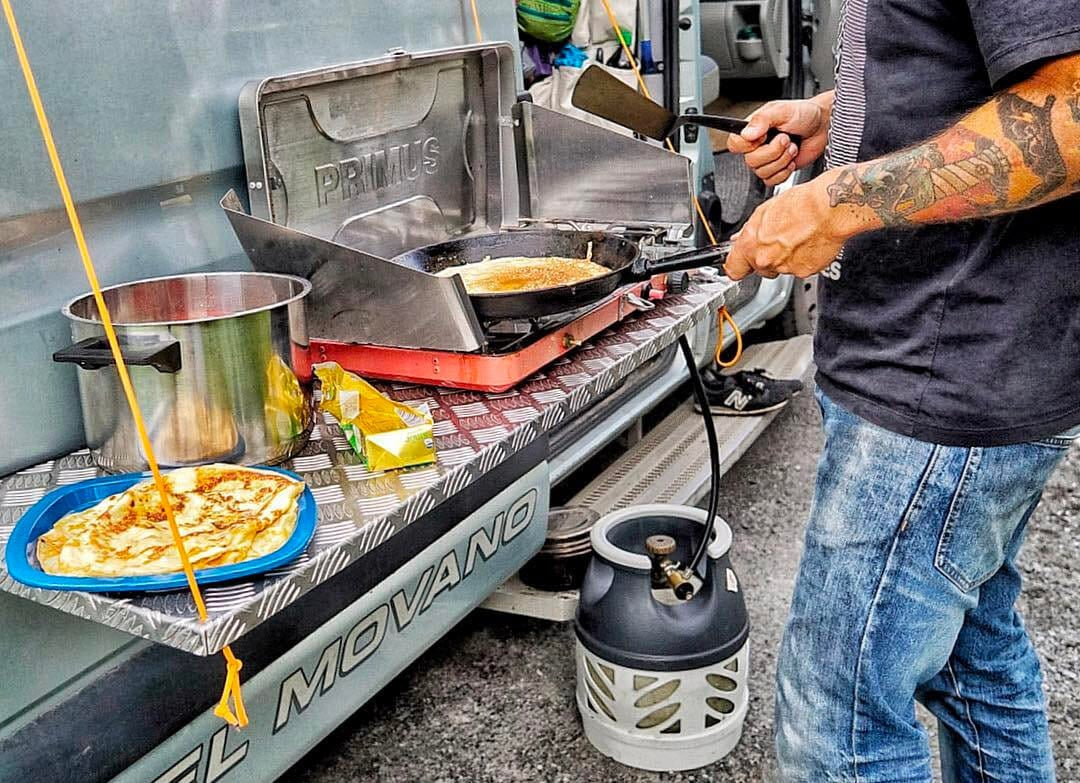
Cooking with Butane
Butane is another common cooking fuel that comes in 8oz cans. Like propane, it can be found in camping stores, Walmart, and Asian food markets.
There are a variety of one burner and that run off butane fuel. We use a butane one-burner ourselves. These stovetops work similarly to the propane versions with a few key differences:
- Butane is more expensive than propane per BTU when bought for cooking.
- Butane canisters cannot be refilled
- Butane is denser; there is 12% more energy in butane than a propane canister of the same volume.
- Butane does not work as well as propane or liquid fuels in temperatures below 30F.
- Generally, butane stoves have a clip-in connector and propane stoves have a screw on connector
Both butane and propane have the similar BTUs, meaning one will not cook faster than the other. That said, Butane has more energy than propane by volume so the same size can will last longer.
Cooking With A Hybrid Fuel Mix
IsoButane fuel is a common mix between propane and butane. A hybrid mix of fuel can be the best of both worlds.
You get the higher energy density of butane combined with the cold temperature performance of propane.
IsoButane is most commonly used in portable compact stoves designed for backpacking such as the MSR Windburner and JetBoil. This is the most efficient way to boil water or heat small amounts of food. If you are frequently making coffee, tea, or soup, compact stoves outperform larger one burner stoves and electric water boilers.
Although this type of fuel is highly efficient, it is also relatively expensive per BTU. This makes hybrid fuel a great choice for boiling water, but when it comes to simmering or cooking for long periods of time the alternatives are usually better.
Because compact stoves pack down so small, we keep one as a secondary stove option for cooking hot drinks. They also make a great backup solution if there are any issues with the primary stove. Hybrid fuel is easy to find and canisters can be bought at Walmart.
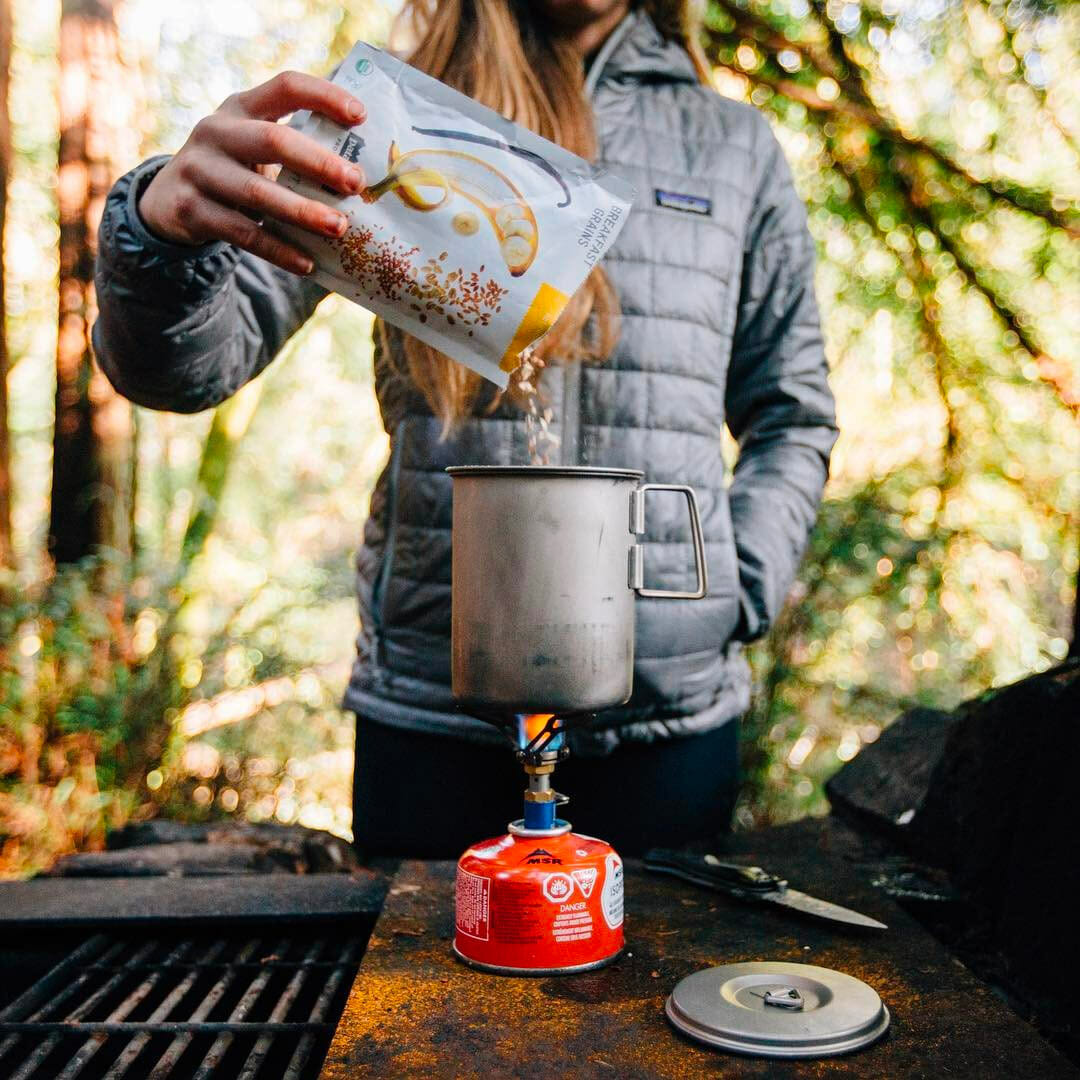
Cooking with Diesel
Diesel is not a common cooking fuel. However if you drive a Diesel vehicle, there are products that allow you to tap into that gas tank!
Diesel stoves and are meant to be stationary and were mainly produced for boats.
For all systems, it will be necessary to build in a fuel intake and a fuel exhaust. The diesel system requires a lot of work to build out. But once the product is up and running, it’s inexpensive to maintain. Plus you don’t have to lug around extra fuel.
Diesel burns dirty, but with dedicated ventilation, excess smoke and exhaust will vent outside the vehicle and won’t produce extra humidity.
Like propane, diesel systems can be used to power more than just kitchen appliances. This makes diesel a one-size-fits-all choice for a van setup.
Cooking with Other Liquid Fuels
Liquid fuels are a cheap way to heat food, but also come with a few challenges. As a liquid, fuels like alcohol are prone to spills and can create quite a mess when cooking.
Alcohol
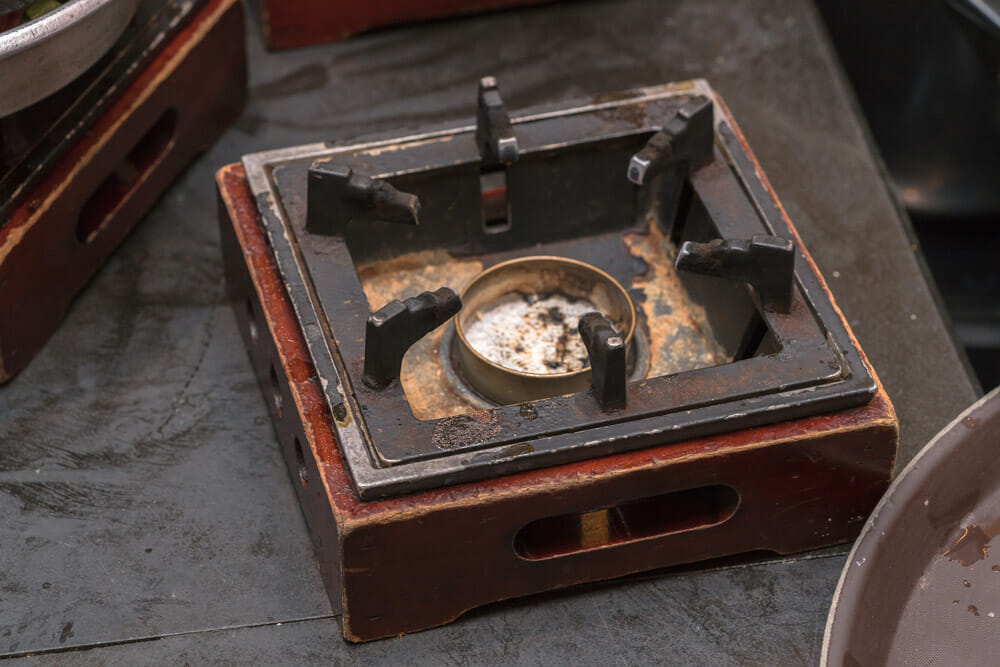
Alcohol stoves can be purchased for under $20, pack up tiny, and work in any weather. If you want to go the DIY route, you can even build your own!
An alcohol stove’s heat level is not adjustable, and it will take some getting used when learning how much alcohol to use.
Rubbing alcohol and isopropyl burn sooty, so try to find denatured alcohol if you have the choice. Denatured alcohol burns the hottest of the three. Some people use white gas
As with all cooking fuels, don’t forget the carbon monoxide detector and ventilation!
Sterno
Sterno is often used to heat buffets and fondue pots. It is a mix of denatured and jellied alcohol and can be used to heat food on a small camp stove.
Sterno is the cheapest fuel on our list and also has the least amount of BTUs per dollar making it the most inefficient as well. This dirty, sooty fuel is not recommended for cooking indoors.
White Gas (Coleman cooking fuel)
This is the liquid fuel that the older stoves and camp lanterns run off of it is better for outdoor use because it’s not the cleanest burning. Works well in pressurized cooking systems and has a low boiling point so is good for cold weather. It’s also widely available across North America
Kerosene
Like Sterno, Kerosene is a dirty and inefficient fuel. Although both can be used to heat small camp stoves, we recommend denatured alcohol if you are trying to savemoney. Kerosene is available worldwide for those international adventurers.
Cooking with Electric
Electricity is generally quite pricey to use for heating food on location. It takes a lot of components to functionally heat coffee or fry an egg.
If you’re already installing a relatively large solar setup or running a generator it becomes more economical. If not, think about it this way: For a small single induction cooktop on high you would need a 1500 watt inverter and a big enough battery bank to deliver 100 amps to that inverter. That’s a lot of juice! Slow cookers and coffee makers aren’t much better.
That said, if electric items are important to you there’s nothing wrong with using them. Just be aware of that the energy density of batteries compared to fuel makes it more challenging in a small contained space such as a van.
With all of the varying electric items, and our focus on fuel – we’re going to save this breakdown for another article.
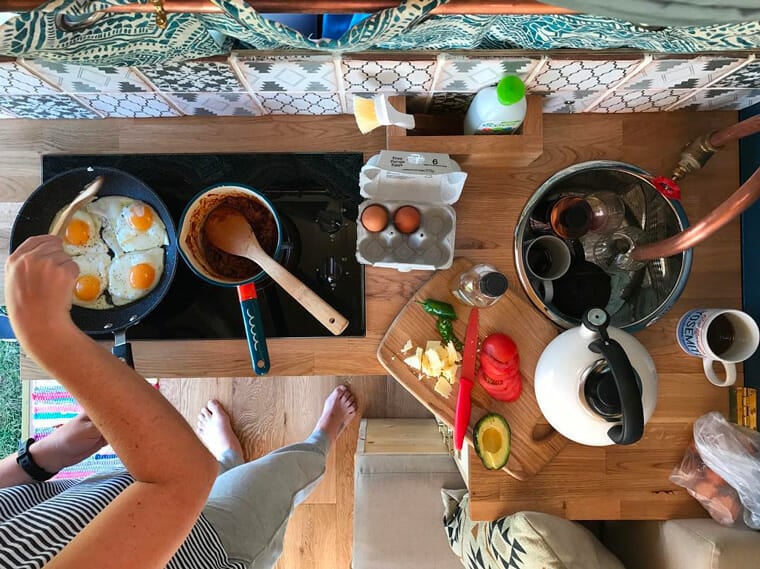
Solar Cooking And Fire
Cooking with solar and fire deserve a mention. If you happen to find yourself on a tight budget, campfires are a fantastic way to cook. There is a plethora of campfire meals online that are simple and delicious. One of our favorite websites to find ideas is Pinterest.com.
Solar Cooking
Grab your sunglasses! Solar cooking is the process of using reflective materials to direct sunlight towards a pot of food. These can be made with aluminum and cardboard or purchased online for just a few dollars. In the right conditions, they can heat up to 250ºF. Solar cookers work best in hot, tropical climates.
There are a number of different of solar cooker types, all of which are inexpensive. To learn more about solar cookers, or how to make your own check out insteading.com.
How To Decide What’s Best For You
Some of us use a single small pot so we can devour a fast bit of soup and then bask in parks. Others craft multi-course mouthwatering meals out of their four-wheeled kitchen. Fuel choice can be narrowed down by lifestyle and budget with respect to their different qualities. Fortunately, there are options for all folks and
- If you are under a tight budget: look into cooking with campfires, alcohol stoves or solar energy.
- For simple everyday meals: consider cooking with butane or propane canisters.
- For larger setups that can power entire systems: check out propane tanks or electricity.

Super helpful breakdown of btu to dollar! Also check out the wonder bag or other products that insulate large pots to cut down on costs.
Thanks for the info! I’m in the process of designing and building my van conversion and this was exactly what I was looking for! Love your site and all you’re doing to help others 🙂
Hi,
In regards to electrical cooking options, you mentioned that you would go into more detail in another article..does that article exist yet? If so, do you have a link??
Thanks for all the help!